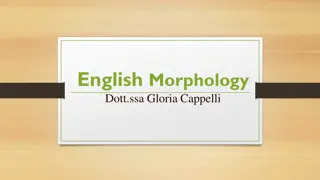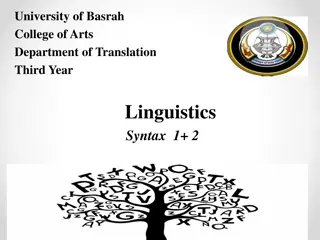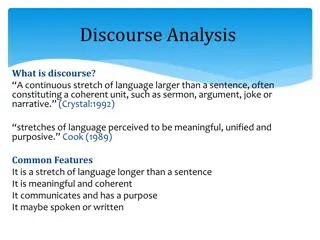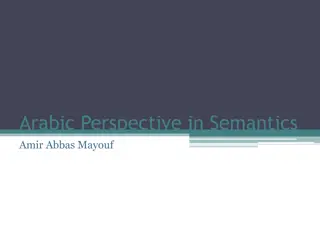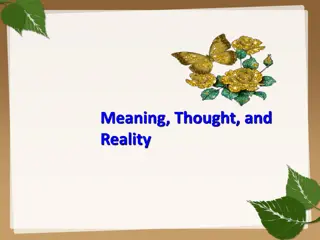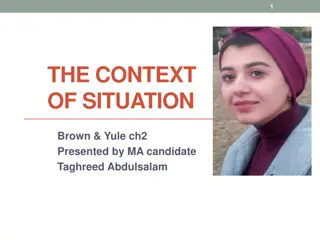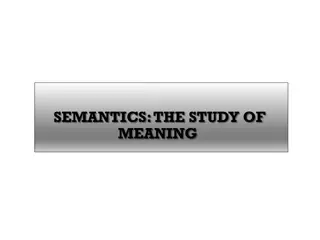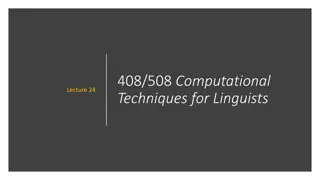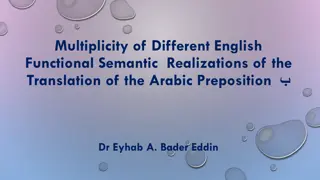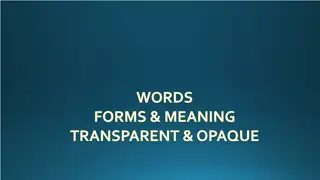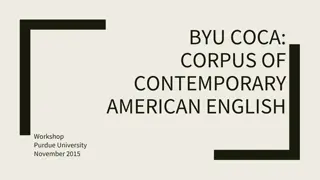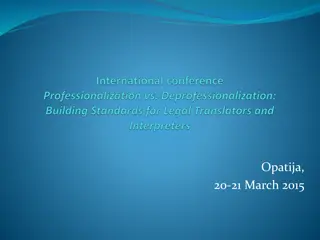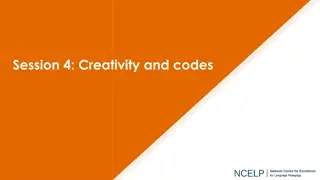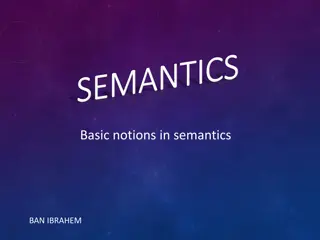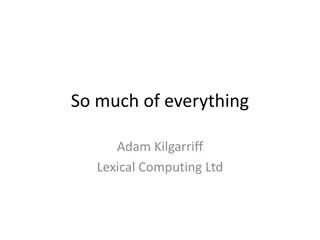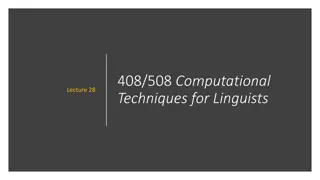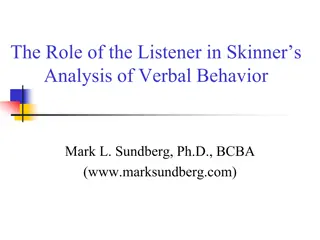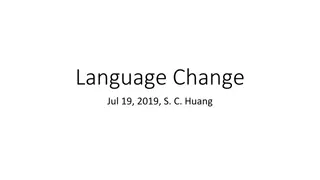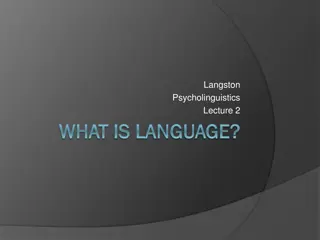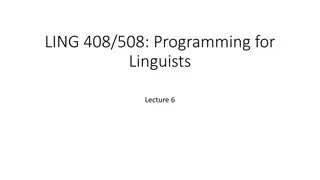The Significance of Media in Language Learning
Media plays a crucial role in language learning by raising awareness of the ideology behind linguistic structures and providing valuable information on society and culture. Linguists are drawn to media language for research purposes and to understand its impact on language use and attitudes. Media s
12 views • 5 slides
Understanding English Morphology: The Study of Words and Meaning
English Morphology delves into the structure of words, exploring morphemes as the building blocks of linguistic meaning. From free morphemes like "certain" to bound morphemes like "-ly," the discipline uncovers how words are constructed and adapted grammatically. By examining the derivational and in
0 views • 49 slides
Understanding Syntax in Linguistics
Syntax, originating from Greek meaning arrangement, deals with the structure of sentences in a language. Generative Grammar, coined by Noam Chomsky, uses rules akin to mathematics to create new, grammatically accurate sentences. By applying recursion and deep structure analysis, linguists explore th
2 views • 20 slides
Understanding Discourse Analysis: Language in Context
Discourse analysis involves examining larger language units beyond sentences, such as conversations, lectures, and written texts, to understand their coherent meaning and purpose within specific contexts. Emerging in the 1970s, this field shifts focus from idealized language structures to the intera
3 views • 47 slides
Exploring Arabic Semantics in Linguistics by Amir Abbas Mayouf
The article delves into the Arabic perspective in semantics as studied by linguists like Amir Abbas Mayouf. It discusses the definition of semantics, the difference between semantics and meaning, and the role of semantics in language sciences. The linguistic context, lexical reference, and phonetic
2 views • 15 slides
Various Definitions of Language Throughout Linguistic History
Different linguists and scholars have offered various definitions of language over time. Sapir (1921) emphasized language as a method of communicating ideas, emotions, and desires through voluntary symbols. Bloch and Trager (1942) focused on the social aspect of language as a system of vocal symbols
1 views • 12 slides
Exploring Meaning, Thought, and Reality in Linguistics
Delve into the fascinating realm of semantics and linguistic theories, where the interplay between language, thought, and reality is deciphered. Concepts like reference, denotation, and the relationship between linguistic expressions and the world are explored through the works of renowned linguists
0 views • 37 slides
Understanding the Importance of Context in Linguistic Interpretation
Linguists have increasingly recognized the significance of context in interpreting sentences since the 1970s. Contextual features, as discussed by scholars like Firth, Hymes, and Lewis, play a crucial role in understanding utterances within specific social and communicative settings. Co-text and the
0 views • 14 slides
Exploring Semantics: The Study of Meaning
Semantics is a branch of linguistics that delves into the study of meaning in language. It involves understanding how words and constructions combine to convey semantic acceptability. Linguists explore lexical and sentence meanings, semantic fields, synonyms, opposites, and more to decipher linguist
0 views • 21 slides
Computational Techniques for Linguists Lecture 12: HTML Elements Styling Guide
Today's lecture covers inline styling in HTML elements using tags like and 9 views • 18 slides
Exploring Computational Techniques with NLTK for Linguists
Dive into the world of computational techniques for linguists with NLTK in Lecture 24. Learn about list comprehensions, conditional forms, tokenization, part-of-speech tagging, parsing, chunking, concordance, similarity, common contexts, dispersion plots, and more. Discover where NLTK is installed o
0 views • 22 slides
Analyzing English Functional Realizations of Arabic Prepositions
This paper delves into the complex semantic functions of Arabic prepositions and their varied English translations. By examining the nuanced differences in expression across languages, it aims to enhance understanding for translators and linguists, shedding light on potential ambiguities that can ar
0 views • 12 slides
Understanding Words: Forms and Meanings in Language
Linguists explore the relationship between form and meaning in words, acknowledging that one form can have multiple meanings and vice versa. Different notational conventions are used to distinguish between form, meaning, and the word itself, emphasizing the importance of understanding how words func
0 views • 41 slides
Understanding COCA: Corpus of Contemporary American English Workshop Overview
COCA (Corpus of Contemporary American English) is a valuable resource for researchers and linguists containing a vast database of text types from various registers such as spoken, fiction, magazines, newspapers, and academic sources. This overview discusses the collection timeframe, interface, searc
0 views • 16 slides
Advancing Legal Language Education in Croatia through Lifelong Learning Programs at University of Osijek
In March 2015, the Faculty of Law at the University of Osijek in Croatia conducted a program focused on educating lawyer linguists. The initiative aimed to enhance the skills of FL teachers and lawyers, aligning with Bologna requirements. Workshops on EU Law, Legal Translation, and more were conduct
0 views • 21 slides
Unleashing Creativity through Language Learning and Code-Breaking
Language learning has a profound impact on creativity, with a strong correlation between proficiency in a second language and creative flexibility, fluency, and originality. Delve into the realm of code-breaking linguists and discover the cognitive benefits of bilingualism. Explore a career in the R
0 views • 17 slides
Understanding Semantics: Basic Notions and Definitions
Semantics is a serious academic discipline focusing on the meaning of language. It delves into denotation, connotation, and the semiotic triangle, aiming to provide a clear understanding of how meaning operates in language use. Definitions from notable linguists like John Lyons and insights into sem
0 views • 23 slides
Evolution of the Web: A Journey Through Time
Explore the evolution of the web from its teenage years to modern-day advancements. Witness the transformative impact of technology on democracy, communication, and society. Reflect on the web's growth and changing landscape, from passive information to active interaction. Discover how linguists stu
0 views • 57 slides
Understanding Bigrams and Generating Random Text with NLTK
Today's lecture in the Computational Techniques for Linguists course covered the concept of bigrams using NLTK. Bigrams are pairs of words found in text, which are essential for tasks like random text generation. The lecture demonstrated how to work with bigrams, including examples from the NLTK boo
0 views • 19 slides
Understanding the Role of the Listener in Verbal Behavior Analysis
Traditional views on verbal behavior have often overlooked the critical role of the listener. Skinner's analysis sheds light on the complexity of the listener's behavior and its impact on communication. Linguists focus on what words mean to listeners and the judgment of grammaticality. Skinner empha
0 views • 21 slides
Understanding Language Change and Sound Evolution
Explore the processes and examples of language change, including sound alterations, observed notations, reconstruction methods, and the regularity of sound changes. Discover how linguists analyze conditioned changes, assimilation, and the neogrammarian model to track linguistic evolution.
0 views • 31 slides
Understanding Language Properties and Definitions
Language is defined by its unique properties such as rapid fading, interchangeability, feedback, semanticity, arbitrariness, discreteness, displacement, productivity, cultural transmission, duality, prevarication, reflexiveness, and learnability. These properties help distinguish human language from
0 views • 19 slides
Introduction to Shell Arithmetic and Command.bc for Linguists
Today's lecture covers shell arithmetic, positional parameters for shell scripts, making shell scripts executable, and using command.bc for mathematical computations in the shell environment. Examples and demonstrations on shell arithmetic, utilizing the 'expr' command, and leveraging 'bc' command f
0 views • 21 slides
Language translation company
TranslationSingapore is a premier Language Translation Company committed to delivering precise and culturally sensitive translations for businesses and individuals. With a team of skilled linguists fluent in diverse languages, we specialize in bridgi
1 views • 5 slides

